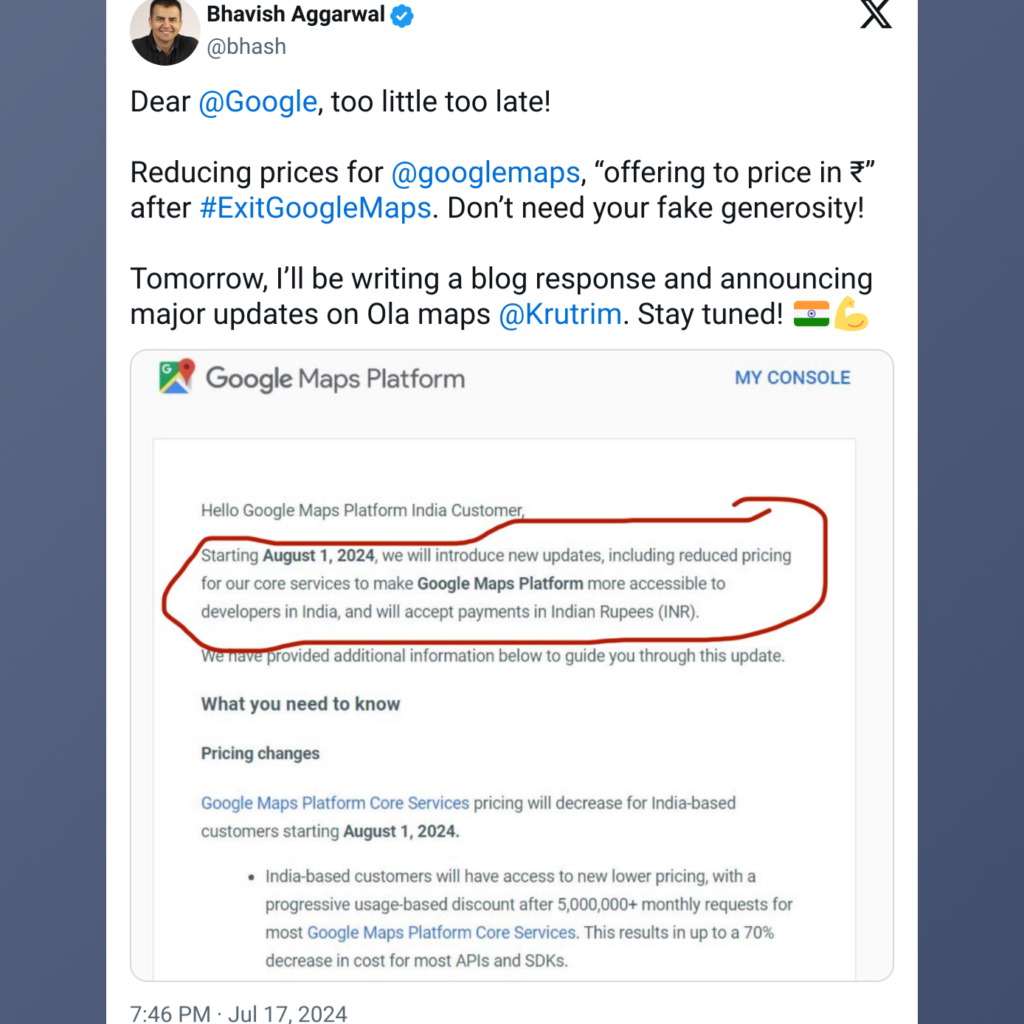In a surprising turn of events, Google has announced a significant reduction in the prices of Google Maps in India, just days after Ola, the popular ride-hailing service, launched its own mapping solution called Ola Maps. This bold move highlights the growing competition in India’s digital cartography space and the potential impact of homegrown technologies on global tech giants.
Table of Contents
- Google’s Swift Response to Ola Maps Challenge
- Ola Maps: The Catalyst for Cartographic Change
- Ola’s Aggressive Strategy in the Mapping Arena
- The Far-Reaching Impact of Ola Maps
- Google’s Response: A Testament to Ola’s Product Excellence
- Ola’s Defiant Reaction to Google’s Price Cut
- The Road Ahead: A New Era in Digital Cartography
- Conclusion: Ola Maps – A Potential Game Changer in India’s Tech Landscape
- External links:
Google’s Swift Response to Ola Maps Challenge
Google recently communicated to its existing Google Maps customers in India about upcoming changes to their service. The message read: “Hello Google Maps India Platform customer. Starting August 1, 2024, we will introduce new updates, including reduced pricing for our core services to make the Google Maps platform more accessible to developers in India, and we will accept payments in Indian rupees.”
This announcement comes with substantial price cuts, potentially reducing costs for power users of Google Maps by as much as 70 percent. The decision to accept payments in Indian rupees is particularly noteworthy, as it addresses a long-standing request from Indian developers and businesses.
Ola Maps: The Catalyst for Cartographic Change
The catalyst for Google’s price reduction appears to be the recent launch of Ola Maps. Ola, primarily known for its ride-hailing services, made waves in the tech community when it announced its switch from Google Maps to its own homegrown solution. The company claimed this move would save them approximately Rs. 100 crore per year.
Ola’s Aggressive Strategy in the Mapping Arena
Taking it a step further, Ola made its mapping platform available on its Krutrim Cloud, offering it for free to customers in the first year. The company also set competitive prices for subsequent years and, crucially, allowed payments in Indian Rupees – a feature that Google had previously not offered.
In a bold move, Ola actively encouraged Indian developers to “exit Google Maps” and adopt their product instead. This aggressive stance seems to have caught Google’s attention, prompting the tech giant to reevaluate its pricing strategy in the Indian market.
The Far-Reaching Impact of Ola Maps
The launch of Ola Maps and Google’s subsequent reaction have several implications for the Indian tech ecosystem:
- Boosting Homegrown Innovation: Ola Maps demonstrates that Indian companies can develop world-class technologies capable of competing with global giants.
- Intensifying Market Competition: The increased competition is likely to lead to better services and more competitive pricing for developers and end-users alike.
- Enhancing Data Sovereignty: A homegrown mapping solution could potentially offer better control over sensitive geographical data.
- Driving Economic Growth: The potential savings for businesses using mapping services could be substantial, contributing to the overall growth of India’s digital economy.
Google’s Response: A Testament to Ola’s Product Excellence
Google’s swift response to Ola Maps is telling. It suggests that Google’s developers have evaluated Ola’s offering and found it compelling enough to warrant immediate action. The fact that a tech giant like Google is adjusting its pricing strategy in response to a new competitor, especially one venturing outside its primary domain, is a rare occurrence and speaks volumes about the potential threat posed by Ola Maps.

Ola’s Defiant Reaction to Google’s Price Cut
Ola CEO Bhavish Aggarwal’s response to Google’s price cuts was particularly noteworthy. In a social media post, he dismissed Google’s moves as “too little too late” and “fake generosity,” promising further updates and enhancements to Ola Maps.
The Road Ahead: A New Era in Digital Cartography
As the maps price war unfolds, the future of digital cartography in India looks increasingly competitive and innovative. While Google Maps has long been the go-to solution for developers and users alike, Ola Maps represents a credible alternative that could reshape the market.
The success of Ola Maps could inspire other Indian tech companies to develop homegrown solutions for various digital services, potentially reducing dependency on foreign technologies and fostering innovation within the country.
Conclusion: Ola Maps – A Potential Game Changer in India’s Tech Landscape
The launch of Ola Maps and Google’s subsequent price reduction underscore the dynamic nature of India’s tech ecosystem. It’s a testament to the power of innovation and the potential for disruption, even in markets dominated by established players.
As Ola Maps continues to evolve and challenge the status quo, it serves as a powerful example of how innovative thinking and strategic execution can shake up even the most established markets. Whether Ola Maps will ultimately succeed in dethroning Google Maps in India remains to be seen, but one thing is certain: the mapping landscape in India will never be the same again.
This story of Ola Maps challenging Google Maps is not just about two companies competing in the digital cartography space. It’s a broader narrative about India’s growing technological capabilities, the rise of homegrown solutions, and the country’s potential to shape the global tech landscape. As we watch this maps war unfold, it’s clear that the real winners will be the Indian tech ecosystem and its users.
External links:
- For more on digital mapping technologies: Overview of Digital Mapping
- To understand the importance of local solutions: India’s Economic Growth and Local Solutions
Thank you for reading the Blog, Click here to check out our other Blogs and Subscribe to our Newsletter.

[…] For more context, Read our previous blog on this story: Ola Maps Sparks Google Maps Price Drop […]